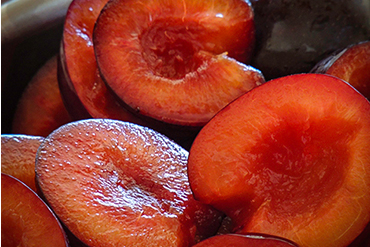
A Plum Passion
- Kitchen Garden
 The South Australian summer is upon us. The garden beds have been prepared with layers of mulch, brown dripper hoses snake through the vege patch and temporary shade structures promise relief from the scorching heat during the endless days of 38 degrees celsius and above. Only the most robust of the mediterranean vegetables; tomatoes, eggplants, capsicum, zucchini and chilies can withstand the desiccating northerly winds that threaten to strangle the life from all and sundry that dally to long in the mid-day sun.
The South Australian summer is upon us. The garden beds have been prepared with layers of mulch, brown dripper hoses snake through the vege patch and temporary shade structures promise relief from the scorching heat during the endless days of 38 degrees celsius and above. Only the most robust of the mediterranean vegetables; tomatoes, eggplants, capsicum, zucchini and chilies can withstand the desiccating northerly winds that threaten to strangle the life from all and sundry that dally to long in the mid-day sun.
But nature serves us well and also provides the cooling qualities of cucumbers, watermelons, cantaloupes, berries and grapes and the lusciousness of stone fruit to refresh and rehydrate us on days of such extremes. And how ironic that during this heat, preserving an abundant harvest invariably involves stirring cauldrons of bubbling fruit, sugar and vinegar mixtures as they are transformed into jams, jellies, chutneys, and pickles.
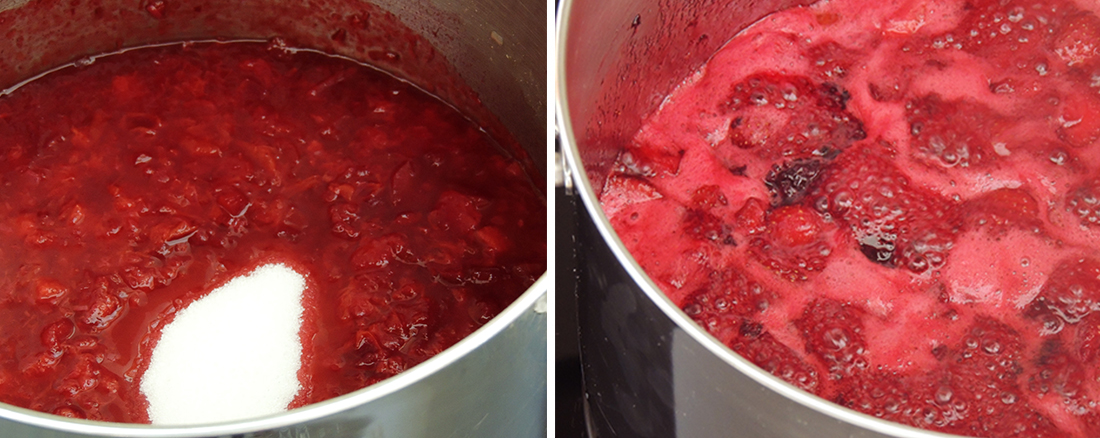 As the stone fruit in our kitchen garden ripen a little more with each day, I have but a moment for reflection before the harvest begins.
Have the pantry shelves been sorted? Have enough of last years harvests been divvied up and shared amongst the friends and rellies? Jars, are there enough? There must be lots, cleaned of labels, waiting with their lids. Have enough been collected from my trusted legion of volunteers who conscientiously save, store and proffer their stash in exchange for my preserves. They all have their favourites and there are standing orders. Finally, the preserving alchemists essentials, an assortment of sugars, vinegars and exotic spices must be at hand.
As the stone fruit in our kitchen garden ripen a little more with each day, I have but a moment for reflection before the harvest begins.
Have the pantry shelves been sorted? Have enough of last years harvests been divvied up and shared amongst the friends and rellies? Jars, are there enough? There must be lots, cleaned of labels, waiting with their lids. Have enough been collected from my trusted legion of volunteers who conscientiously save, store and proffer their stash in exchange for my preserves. They all have their favourites and there are standing orders. Finally, the preserving alchemists essentials, an assortment of sugars, vinegars and exotic spices must be at hand.
Plums will be the first of our stone fruit this year. Belonging to the Prunus genus of plants they are botanically related to the cherry, peach, apricot and nectarine, as they have a hard stone pip that surrounds their seed. They are commonly referred to as stone fruit by the layman or drupes within horticultural circles. Plums are distinguished from apricots and peaches as they bear fruit on stalks likes cherries but they have a flattened pip where the cherry pip is round.
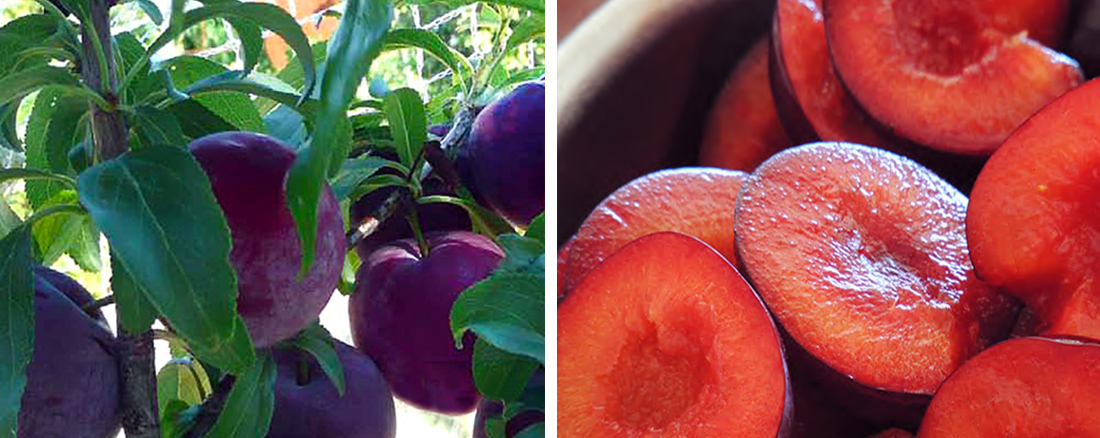
There are five main plum species with the most relevant to Australian gardeners and the culinary minded being the European plum (Prunus domestica) and the Japanese plum (Prunus salicina). The most common Japanese varieties are Santa Rosa and Satsuma while the Angelina Burdett and D’Agen, the French prune which is best eaten dried, are the most popular European varieties.
Prunus cerasifera, the myrobalan or cherry plum is a popular street tree in temperate climates because of it’s attractive purple foliage, convenient size and masses of late winter white blossom. Native to the Balkans, northern Iran and Russian Asia, it is considered to be one of the parents of the modern European plum. Prunus spinosa, the sloe or blackthorn, native to Caucasus, bears small blueish astringent almost inedible fruit. It is best known as a flavouring for gin and is considered to be the other parent of the European plum. Prunus insititia is a group of plums that are sometimes classified as a sub group of the European plum.
This group contains; damsons which are highly regarded in culinary circles for their sweetness and spicy tang, mirabelles, venerated by the French for their fragrance, are used in preserves and tarts, bullaces that remain sour even when ripe and very few varieties are eaten raw and the St. Julians which are used as a rootstock plant and have fruit similar to the damson.
Mature plums have a distinctive glaucous appearance which comes from the pale grey or blueish-green waxy bloom on the ripened skin. Glaucous coverings are one of mother natures marvelous interventions. Hydrophobic in nature, this covering assists in the prevention of rain spoilage as water rolls off the skin. It is also thought to function as a deterrent to small climbing and feeding insects as they can’t maintain their grip as they try to feed upon the luscious fruit juice.
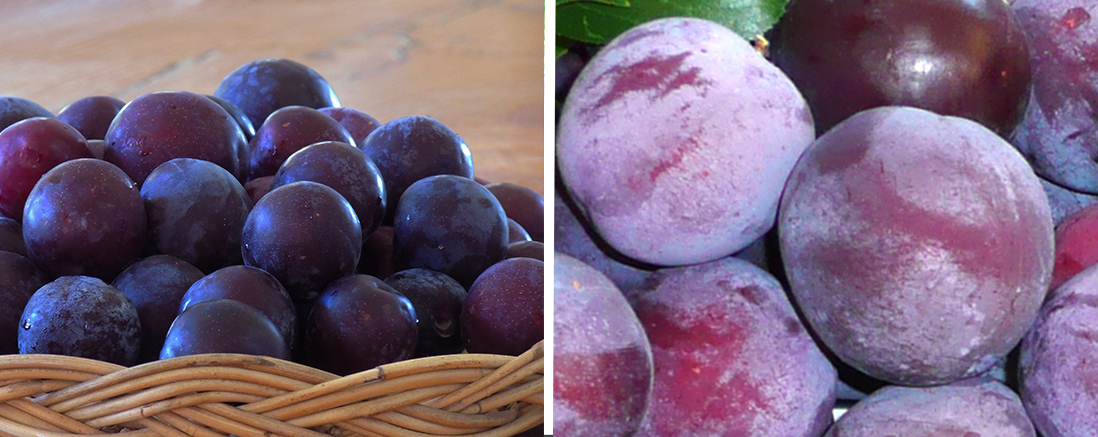 Once picked ripe fruit will only last 1-2 weeks. With too much to eat as fresh fruit, processing the abundant plum harvest is about to commence. So, as the fruit ripens to perfection in the next couple days, this is the last chance to retrieve my favourite plum recipes and seek out new ones. Soon my kitchen will be filled be with the fragrant and heady aromas of plum cake, strudel and clafouti as well as plum and ginger chutney, classic plum jam, spiced vanilla jam, plum syrup, chinese-style plum sauce and pickled spiced plums.
Once picked ripe fruit will only last 1-2 weeks. With too much to eat as fresh fruit, processing the abundant plum harvest is about to commence. So, as the fruit ripens to perfection in the next couple days, this is the last chance to retrieve my favourite plum recipes and seek out new ones. Soon my kitchen will be filled be with the fragrant and heady aromas of plum cake, strudel and clafouti as well as plum and ginger chutney, classic plum jam, spiced vanilla jam, plum syrup, chinese-style plum sauce and pickled spiced plums.
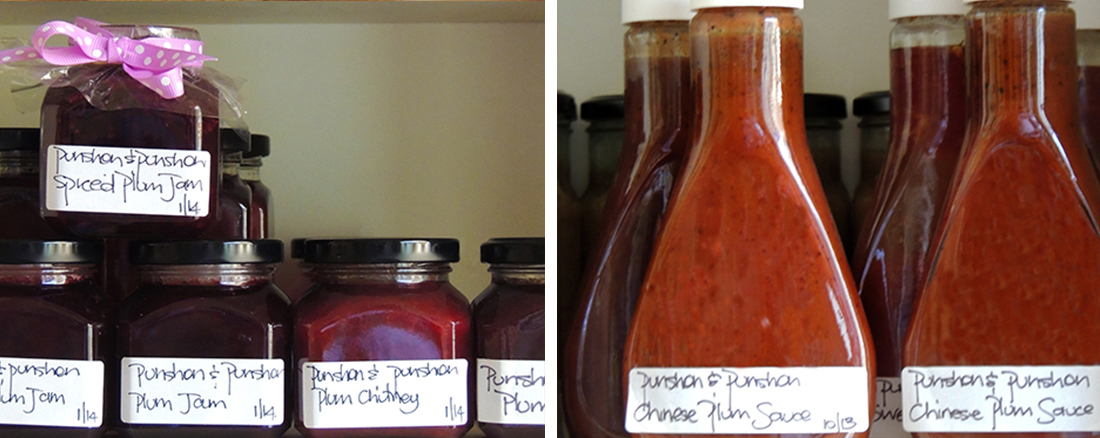 When the last of the preserved plums have been packed away, the cycle will re-commence with the nectarines and peaches, to be followed by the late apricots, then the figs, apples, pears and lastly the quinces and pomegranates. The stone fruit harvest is a time of excitement, reward and reflection. Savouring the first produce of the season is the reward for nurturing and meeting the challenges that each season brings. Eaten fresh from the tree, bursting with flavour, this hedonistic experience, the pleasure of the first of the season is natures gift, a reward, not a commodity.
When the last of the preserved plums have been packed away, the cycle will re-commence with the nectarines and peaches, to be followed by the late apricots, then the figs, apples, pears and lastly the quinces and pomegranates. The stone fruit harvest is a time of excitement, reward and reflection. Savouring the first produce of the season is the reward for nurturing and meeting the challenges that each season brings. Eaten fresh from the tree, bursting with flavour, this hedonistic experience, the pleasure of the first of the season is natures gift, a reward, not a commodity.
